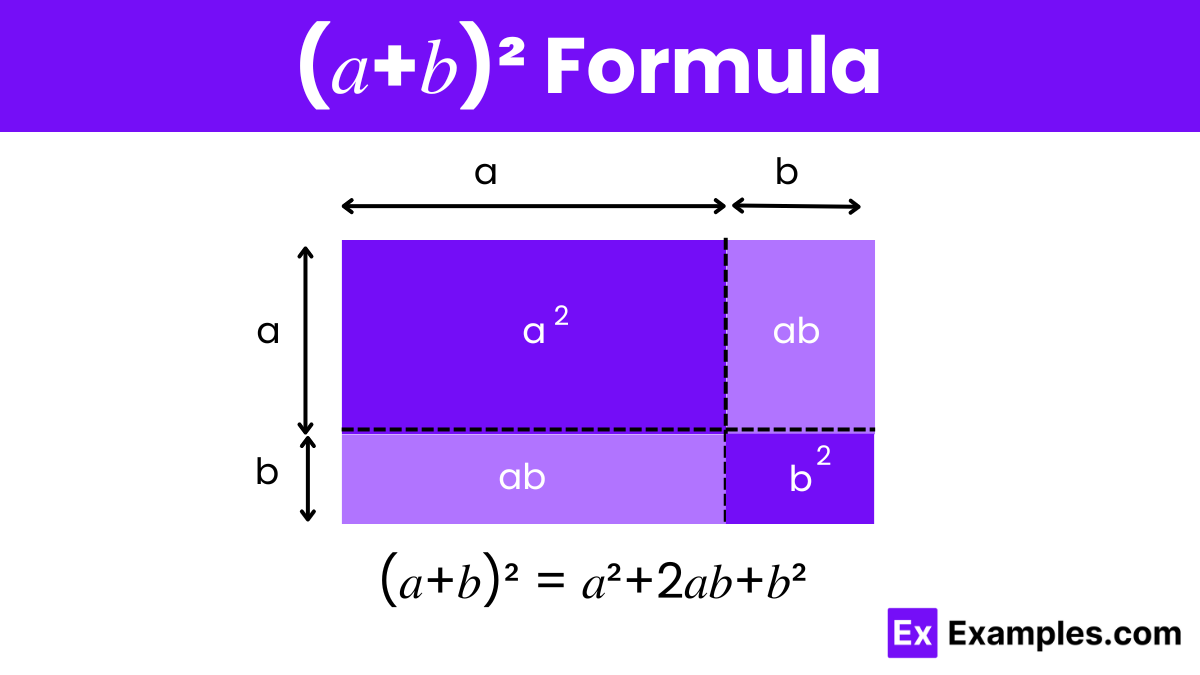What is the value of (5 + 3)²?
48
56
64
72


The formula (𝑎+𝑏)², commonly known as the square of a binomial, is a foundational concept in algebra that simplifies to 𝑎²+2𝑎𝑏+𝑏². This expression plays a crucial role in various mathematical calculations, including those involving rational and irrational numbers, integers, and more complex algebraic structures. In contexts ranging from elementary algebra to more advanced applications like statistics and the least squares method, this identity helps in expanding equations and simplifying computations. Understanding how to apply and manipulate this formula is essential for solving quadratic equations, optimizing numerical methods, and analyzing data variability in statistical models.
The expanded form can be derived using the distributive property (also known as the FOIL method for binomials):
Combining these, you get 𝑎2+𝑎𝑏+𝑏𝑎+𝑏², which simplifies to 𝑎²+2𝑎𝑏+𝑏² because 𝑎𝑏 and 𝑏𝑎 are equivalent.

A geometric proof of the formula (𝑎+𝑏)² = 𝑎²+2𝑎𝑏+𝑏² effectively demonstrates how algebra and geometry can work together to confirm mathematical truths. This proof uses a simple geometric construction involving a square and rectangles. Here’s a step-by-step explanation of the proof:
Add up the areas of the smaller squares and rectangles inside the large square: 𝑎²+2𝑎𝑏+𝑏²
Since both the area of the large square and the sum of the areas of the squares and rectangles inside it represent the same total area, you can equate them: (𝑎+𝑏)² = 𝑎²+2𝑎𝑏+𝑏²
This geometric proof not only confirms the algebraic identity (𝑎+𝑏)² = 𝑎²+2𝑎𝑏+𝑏² but also provides a visual and intuitive understanding of why the formula works. The proof is particularly useful in educational settings, where visual learning aids can help deepen understanding and retention of algebraic concepts.
Problem: Calculate (3+5)² using the (𝑎+𝑏)² formula.
Solution:
Identify 𝑎 and 𝑏:
Let 𝑎 = 3 and 𝑏 = 5.
Apply the (𝑎+𝑏)² formula: (𝑎+𝑏)² = 𝑎²+2𝑎𝑏+𝑏²
(3+5)2 = 3²+2(3)(5)+5² = 9+30+25 = 64
Conclusion: (3+5)² calculates to 64, confirming the formula’s correctness as 8² also equals 64.
Problem: Expand and simplify the expression (𝑥+4)².
Solution:
Identify 𝑎 and 𝑏:
Let 𝑎 = 𝑥 and 𝑏 = 4.
Apply the (𝑎+𝑏)² formula: (𝑎+𝑏)² = 𝑎²+2𝑎𝑏+𝑏²
(𝑥+4)² = 𝑥²+2(𝑥)(4)+4² = 𝑥²+8𝑥+16
Conclusion: The expanded form of (𝑥+4)² is 𝑥²+8𝑥+16, illustrating how the formula simplifies algebraic binomial squaring.
Problem: If the side length of a square is increased by 2 cm, and the original side length is 6 cm, find the area of the new square.
Solution:
Conclusion: The area of the new square with side length 8 cm is 64 cm², easily calculated using the (𝑎+𝑏)² formula.
The formula (𝑎+𝑏)² = 𝑎²+2𝑎𝑏+𝑏² is primarily used to expand and simplify expressions where two terms are squared together. It is a fundamental algebraic identity that helps in solving quadratic equations, simplifying algebraic expressions, and calculating areas in geometric contexts.
Yes, the (𝑎+𝑏)² formula is versatile and can be applied to any numbers—integers, decimals, fractions, and even irrational numbers—as long as they adhere to basic algebraic rules.
Mastering the (𝑎+𝑏)² formula equips students with the skills to handle complex algebraic operations, enhances their problem-solving capabilities, and lays a solid foundation for advanced mathematical studies, including calculus and beyond. It also aids in standardized tests that often include algebraic manipulations.
Text prompt
Add Tone
10 Examples of Public speaking
20 Examples of Gas lighting
What is the value of (5 + 3)²?
48
56
64
72
Calculate (4 + 7)².
110
121
132
144
Find the value of (6 + 2)².
32
48
64
100
What is the expanded form of (7 + 5)²?
100
120
130
144
Calculate (8 + 3)².
110
121
144
169
Find the value of (9 + 1)².
81
91
100
121
What is the expanded form of (10 + 5)²?
200
225
250
275
Calculate (11 + 3)².
160
180
196
225
Find the value of (12 + 4)².
256
288
324
400
What is the expanded form of (13 + 7)²?
300
324
350
400
Before you leave, take our quick quiz to enhance your learning!

